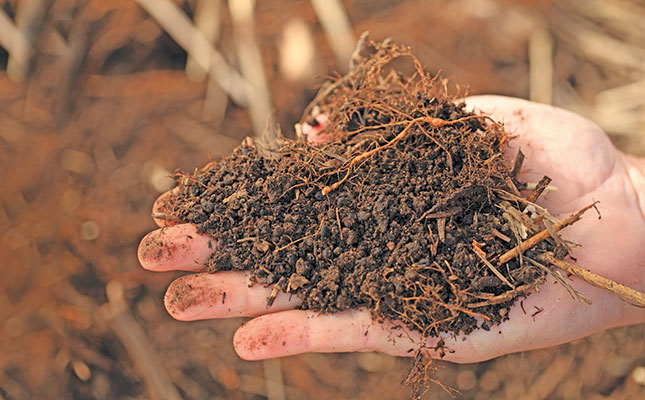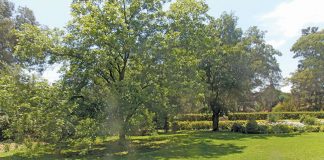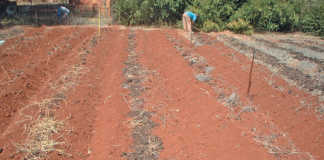
Photo: Glenneis Kriel
ZZ2 and Natuurboerdery
Two decades ago, ZZ2 embarked on a journey that steered away from conventional agriculture towards a system more in tune with nature. They called this farming approach Natuurboerdery.
It is based on a set of principles aimed at economic, social and environmental sustainable agriculture, inspired by insights gained from living ecosystems.
The approach is much broader and encompassing than ‘conservation farming’, which makes use of minimum- to no-till, stubble retention and crop rotation to conserve soil health, and includes most of the components of regenerative agriculture, such as the use of mulching, compost teas and compost to build soil health.
Natuurboerdery seeks not only to regenerate, but to improve and actively build productive and functional novel ecosystems.
Retief du Toit, a member of ZZ2 who has been using Natuurboerdery since 2001, talks about his experiences with this farming approach on the farms Lorraine in the Warm Bokkeveld and Bokveldskloof in the Koue Bokkeveld.
What were some of your fears when you switched to Natuurboerdery in 2001?
We were afraid the switch might negatively affect fruit yields and quality, but our yield curve has been consistently upward and the overall quality of our product has remained excellent.
The switch resulted in higher potassium levels in the soil, which we feared might exacerbate problems with bitter pit, a common apple disorder that causes dark spots. But it didn’t, revealing once again nature’s incredible ability to balance and maintain itself.
What were some of your observations during those first few years?
The soil carbon levels and structure improved, creating a more favourable environment for soil organisms. A change also occurred in the weed spectrum, with overall problems with weeds decreasing.
The water-holding capacity of the soil improved, resulting in better water infiltration, less run-off and better wetting of the subsoil during irrigation.
We saw changes to the root systems of the trees, enabling the trees to seek nutrition and water over a wider area.
The healthier production environment allowed us to reduce our dependence on harsh pesticides and also our use of inorganic fertilisers.
What are some of the biggest mistakes farmers make when taking this route?
To give up. One of the problems with Natuurboerdery is that it is difficult to quantify or translate the benefits into a monetary value, and the start-up costs are high, as you need special equipment and plenty of compost. Also, you need to use good-quality compost or you’ll only create more problems for yourself.
Another problem is that people are afraid of change, so instead of abandoning their old ways, they continue using their old plant nutrition practices, which then double production costs as they now have to pay for the old inputs and the new more environmentally friendly ones.
What kept you going when you experienced problems?
With the introduction of compost, our focus shifted to caring for the plants, which helped us rediscover old truths. The fact that we managed to sustain really high production with above-average fruit sizes was also a great motivator. We saw the benefits from day one and never doubted what we were doing.
To what do you attribute your success with Natuurboerdery?
We use science as a guideline to calibrate decisions in line with the needs of the soil and plant, and all the problems we experienced were approached with a will to solve them.
We measure everything. This helps us gain more insight and better understand what’s happening in and around the plants. This, in turn, allows us to make informed decisions.
In addition, we’ve had strong technical support.
What does the future hold for Natuurboerdery?
Like natural ecosystems, farming is dynamic and ever-evolving. You have to start working today on solutions for the problems of tomorrow. We’re trying to address this by sourcing and developing talented young people to build on our farming legacy.
We’re embracing the Fourth Industrial Revolution by working on data-driven solutions to improve our ability to understand and manage the relationships between production factors, such as the soil, water, genetic varieties and so forth, and on-farm practices.
In addition, we’re researching plant protection strategies based on beneficial and predator insect populations and pheromone technologies to further improve our integrated pest management strategies. We’re constantly looking at nature for ways to improve our overall resilience.
Email Retief du Toit at [email protected].
Regenerative farmer
Danie Slabbert has been farming maize, soya beans, wheat and sunflowers at Van Rooyenswoning near Reitz, in the Eastern Free State, for just over 20 years.
He used conventional farming practices during his first eight years on the farm, after which he switched to conservation farming practices. He bought Drakensberger cattle for ultra-high-density grazing when he started his regenerative farming journey a little over three years ago.
What motivated you to switch to regenerative agricultural practices?
Growing up on a farm, I’ve always been close to nature and aware of our deep dependence on nature for water, food, heat and, in effect, life. I did a lot of research to identify ways to reduce our farm’s environmental footprint, and in the end settled on conservation farming, which later made way for regenerative farming, because of the way in which these farming approaches mimic nature.
How were the first few years after you made a switch to conservation and regenerative agriculture?
The results were absolutely astounding. The soil structure improved significantly within
the first year after our switch to conservation farming. We saw an almost immediate shift in the macro-organism populations on the farm, coinciding with a huge boom in bird life, insects and earthworms.
Conservation farming and regenerative farming, however, are not miracle cures. All the years of damage are not miraculously fixed once you embark on these paths. The early signs are mere indicators that you’re on the right track; it takes quite some time for the soil to heal and become regenerative.
Did you experience any yield losses after making these switches?
No, our long-term production average has remained relatively stable and even increased a little, while our chemical and fertiliser costs declined over time.
A drop in yields is usually an indication something is wrong. It’s easy to blame the system when things get tough, but with conservation and regenerative farming, problems are usually associated with management mistakes.
While conservation and regenerative farming systems are more climate-resilient and often more disease-tolerant, they’re less forgiving of management mistakes in terms of planting width, planting depth, the timing of operations and so forth.
They also require much better planning and management than conventional farming,
as they don’t work from a set of instructions that should be followed each month. With
these systems, you have to be constantly aware of what’s happening on your land and adapt as needed.
You also have many more factors that should be managed properly, such as livestock and cover crops.
What are some of the mistakes that farmers make when switching to conservation and regenerative agriculture?
Switching to these systems requires a 100% commitment and total mind-shift. You’ll fail if you approach it half-heartedly. You also need to be much more connected with what’s happening in and around the farming ecosystem.
Do you have any advice for farmers who become disillusioned with the system?
Farmers tend to give up easily when the going gets tough. Don’t. Look and reflect on what’s happening around you. Talk to other farmers who’ve taken the same route and see how you can adapt what they have experienced to your situation.
We as farmers are custodians of the land. It’s our responsibility to look after the land and give it to the next generation in a better condition than we received it. We will not be able to do this if we subject our soils to the same industrial farming processes they have been subjected to for the past 70 or 80 years.
Email Danie Slabbert at [email protected].
Grain SA’s Conservation Farming Programme
For the past 20 years, Dr Hendrik Smith has been involved in conservation agriculture research and development. He is the facilitator of Grain SA’s Conservation Farming Programme, which entails the identification and prioritisation of conservation farming projects and implementation, monitoring and evaluation of the projects. The programme, funded by the Maize Trust, involves all farmers, regardless of the size of their operations.
What can farmers expect during the first few years after switching to conservation agriculture?
It really depends on how well the practices have been implemented, with good implementation resulting in fewer problems.
Soils are generally severely degraded because of decades of tillage, ploughing and unsustainable production practices, so grain farmers should not expect too much during the first five years of production. All the same, improved soil cover can result in quick improvements in the water infiltration and water-holding capacity of the soil, and significantly reduce problems with erosion.
Soil fertility usually takes longer to recover and farmers have to address nutrient deficiencies with a combination of organic solutions, such as the use of cover crops, compost, ultra-high- density grazing and non-organic solutions to ensure that crops have access to the nutrients they require when they need them.
Weed pressure also has to be managed carefully to prevent future problems. It’s best to use an integrated management approach that combines the use of chemistry with alternative practices, such as the use of cover crops and animal integration.
Beneficial organisms above and below the soil, such as predatory and parasitic insects that keep problem organisms in check, and mycorrhizae, which help improve the absorption of certain soil nutrients, should increase as the soil recovers.
What are some of the biggest pitfalls when switching to conservation farming?
Many farmers make costly mistakes because of a lack of knowledge and skills. To avoid this, gather as much information as you can about the system. Then test the system on small areas before expanding it to your whole farm. Farmers who carry out their own trials while using technical experts and other farmers as soundboards usually have a much greater success rate than those who plunge into the system without any experience or support. It’s also important to address existing issues, such as soil acidity or salinity problems, before making the switch.
What’s your advice to farmers who want to make the switch?
There is no alternative; farmers have to convert to conservation farming to combat soil degradation, climate change and all the other negative spin-offs associated with over-grazing, tillage and industrial production.
The best way to gain knowledge and skills is to join other conservation farmers and study groups, and continually experiment with ways to improve the system.
Email Dr Hendrik Smith at [email protected].
Regenerative Agriculture Association of South Africa
Andrew Ardington grew up on a farm near Mandeni in KwaZulu-Natal and studied agricultural economics at the University of KwaZulu-Natal. In 2019, he started the Regenerative Agriculture Association of South Africa (RegenAG SA) to create a platform where farmers and consumers can learn more about regenerative agriculture.
How did you become involved in regenerative agriculture?
Three years ago, I bought a small farm near Swellendam along with my sisters, Sally and Cally. We started running a few cows to fix up the degraded lands, using the knowledge I’d gleaned from my uncle, Peter Ardington, who uses regenerative farming principles on his farm Cranburn in KwaZulu-Natal.
This set in motion my part-time study of regenerative agriculture, with lots of reading and YouTube, and the realisation of the role that regenerative agriculture can play in solving some of the world’s most pressing issues.
Agriculture is the single most destructive activity that humans have engaged in, and regenerative agriculture gives us the ability to change it from being degenerative to regenerative. It not only allows us to heal parts of the environment, by fixing carbon, water and nutrient cycles, but promises to improve human health by stopping the degradation of our food.
I started thinking about ways in which I could make a difference. I could go farming, but that would hardly make a dent considering the small size of our farm. I realised there were already a few people across the country practising regenerative agriculture, but most of them were operating in isolation and many miles apart.
There was a need to create a community to help people along their regenerative paths and to be there for when other farmers started to ask questions. So I decided to start RegenAg SA.
Can you tell us a little more about the impact of regenerative agriculture on your uncle’s farm?
Regenerative agriculture has helped to significantly improve soil carbon levels while also reducing the farm’s dependence on chemical control methods.
He stopped the burning of land before cutting and introduced cattle onto sugar cane fields, following the cane cutters, and eating the tops as their winter feed. The manure and urine added valuable nutrients and organic matter to the soil and stimulated soil microbiology. While the harvesting costs were higher because the crop was not burnt, fertilisation and weed management costs were reduced by about 30%.
The practice of fallowing a plantation with green manure before planting a new plantation started in 1996. A full year of fallow was followed by multi-species cover crops, such as sun hemp, sorghum and cow peas, and winter crops, such as oats, rye and vetch.
This, in combination with the animal factor, resulted in mechanical management of plantations no longer being difficult. In addition, the sugar plantations yielded the same crop as neighbouring farms, despite our applying 30% less fertiliser.
Based on your observations through working with RegenAg SA, what can farmers expect when making the switch to regenerative agriculture?
Changing to regenerative agriculture is a process of experimentation, observation and tweaks. Unlike conventional farming, it doesn’t come with a recipe.
You’re working with nature rather than trying to control it with chemicals. Each day you are trying to create as much life as possible on your farm. In most cases, farms experience an initial drop in yield as it takes time for the soil and soil biology to recover. These drops can be nerve-racking; they need to be part of the plan so they don’t scare you off your course.
What are some of the common mistakes farmers make when making the switch?
Farmers might change too fast, without the experience of having done it before, or bail out too quickly when hitting a problem. Don’t dive in blindly. Don’t go cold turkey on your chemicals, but wean your farm and yourself off them.
Formulate your plans, observe what is happening on the farm, and rethink your plans as you progress. There is no quick-fix or recipe.
The time has come to truly become in tune with your land. Do biological soil tests. Don’t just measure the big three: nitrogen, phosphate and potassium. Talk to other farmers who are on the same route, and take advice from biological agronomists; there are more than you think in South Africa.
Why shouldn’t farmers give up too quickly when they hit a rut?
The farmer and the farm are going through some big changes; it’s like a drug addict coming off drugs. By the third year, as your farm regenerates, the biology should start working for you.
This might sound like a long time, but remember that the average farm has been poisoning its biology for decades.
The idea is to get onto a totally different path. There will be rocks and bushes on the path, so plan for them rather than be surprised by them.
Email Andrew Ardingtonat [email protected].













